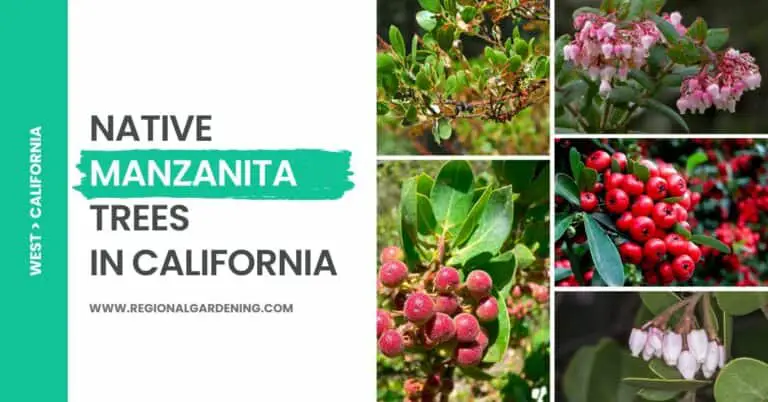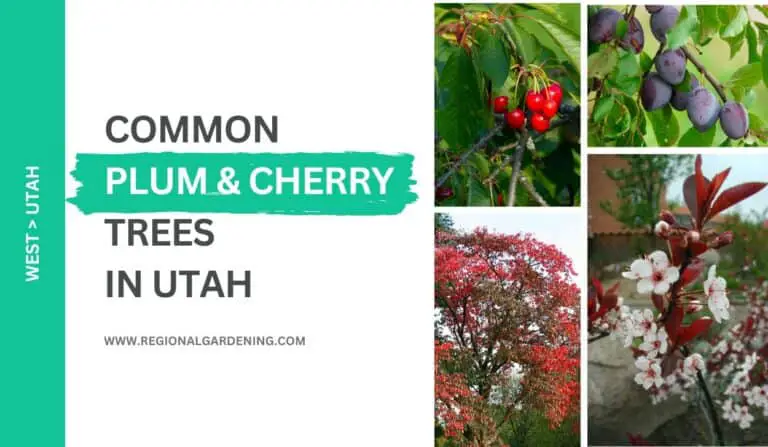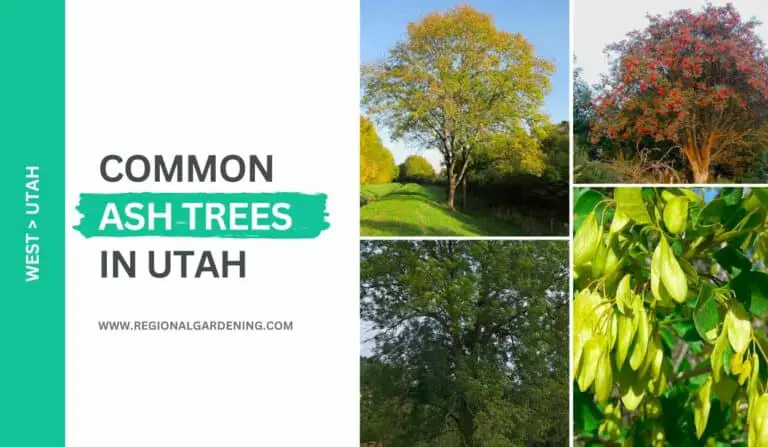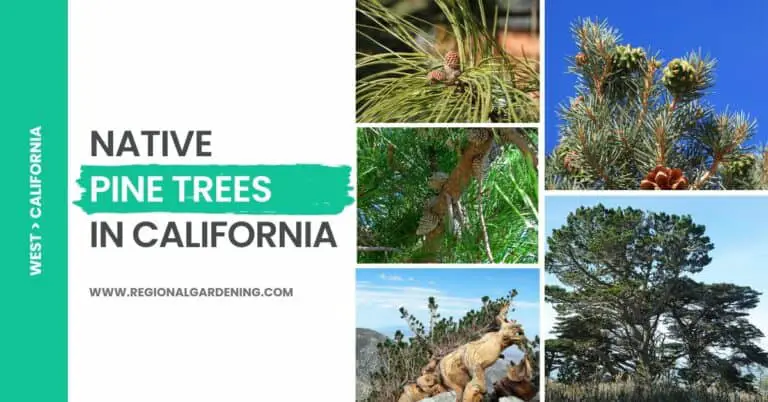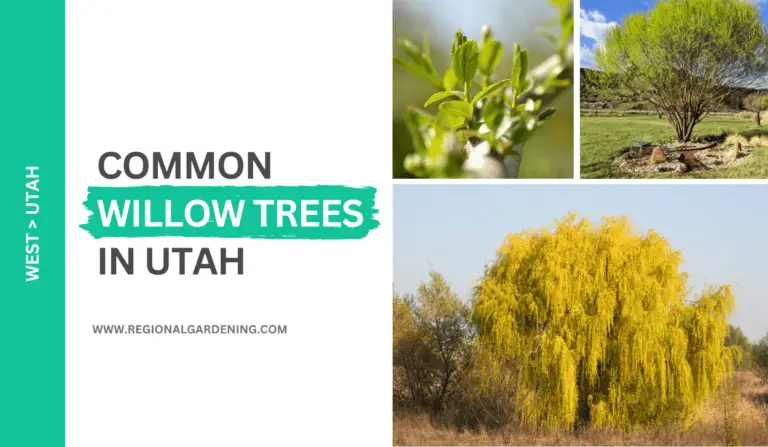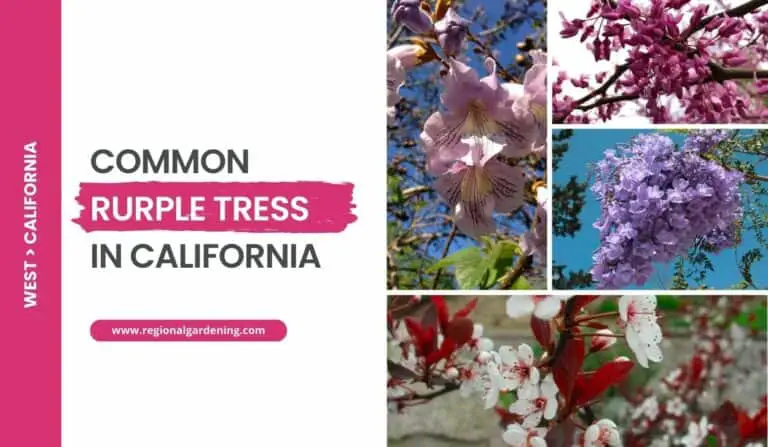15 Common Maple Trees In Utah (Photos & Identification)
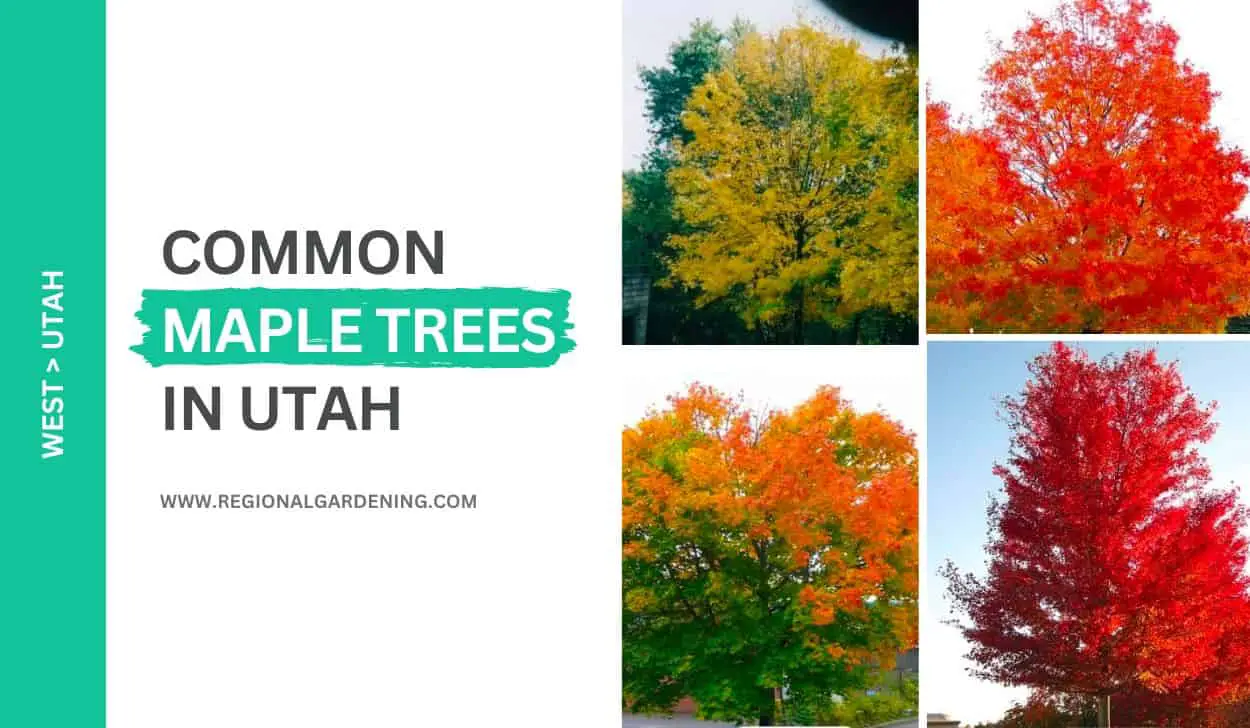
Maple trees have long been admired for their breathtaking beauty and vibrant display of colors during the autumn season. While maple trees are commonly found in the northern and eastern parts of the United States, it may surprise you to learn that Utah has several native species of maple trees.
These majestic trees, ranging from the well-known sugar maple to the more common Silver or Canyon maple, contribute to the remarkable diversity of Utah’s forests and landscapes.
In this article, we will dive into the fascinating world of commonly found maple trees in Utah. Each tree is provided with high-quality photos and detailed descriptions so that you get all the information you need for either identification or growing them in your backyard.
Let’s begin.
1. Boxelder Maple
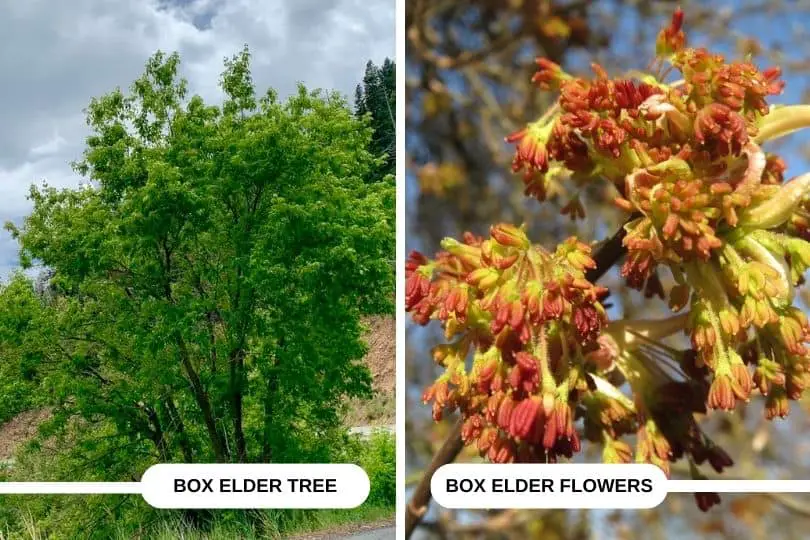
- Common name: Boxelder tree
- Scientific name: Acer negundo
- Mature height: Up to 80 feet
- Native/non-native: Native to North America, including Utah
- Flowers/cones: Small, inconspicuous green to yellow flowers
- Uses: Used for cheap furniture, not important for timber
One of the most commonly found maple trees in Utah, Boxelder, also known as Ash-leaved Maple or Manitoba Maple, is a hardy tree endemic to North America. It has bright green foliage that turns yellow or golden green in the fall and can grow up to 80 feet tall. The leaves were once pinnately complex, with 3 to 7 leaflets and coarsely serrated margins.
The Boxelder tree produces small, inconspicuous green to yellow flowers in March or April that are dioecious, meaning they appear on distinct male and female trees. The tree’s fruit is a samara, which is V-shaped and has two wings and hangs from the tree. It ripens in the autumn.
The bark of the Boxelder tree is thin, pale gray or light brown, and deeply split into rounded, interlacing ridges by furrows. The wood is unimportant and is only utilized for low-cost furniture. The tree is common, but only in poor conditions is it suitable for decorative usage. It is weak-wooded and has intermediate shade tolerance.
The tree is known to thrive in poor soils and arid environments. The Boxelder leaf roller, on the other hand, can nearly entirely defoliate the tree in early June; however, the tree normally grows new leaves without issue. Boxelder bugs, which feed on the fruit of female trees, can also be a nuisance.
2. Canyon Maple
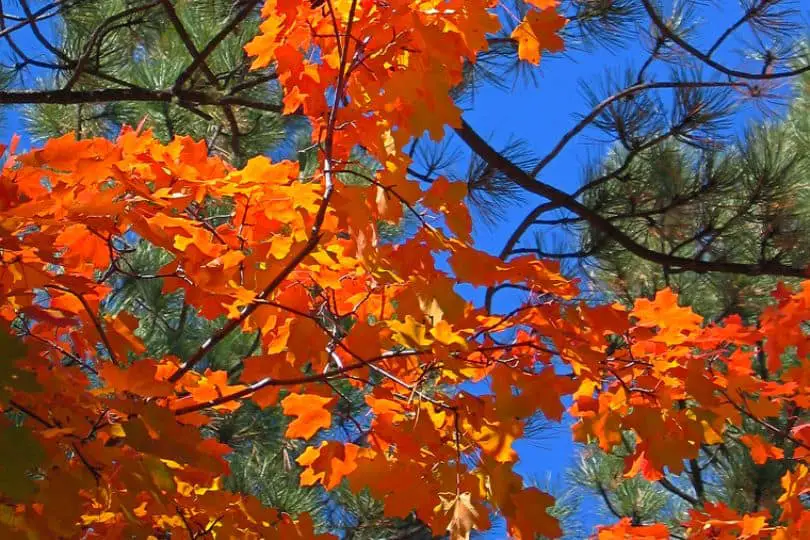
- Common Name: Canyon Maple, Bigtooth Maple
- Scientific Name: Acer grandidentatum
- Mature Height: 20-40 feet
- Native/Non-Native: Native
- Flowers/Cones: Small yellow flowers in spring, followed by green U-shaped samara fruit in fall
The next one on our list of maple trees in Utah is the Canyon Maple, also known as Bigtooth Maple. It is a lovely tree endemic to mountainous areas of the United States which is responsible for the spectacular fall color in Logan Canyon and other northern Utah areas.
This deciduous tree’s leaves are palmately 3- to 5-lobed and 2 to 5 inches wide and long. The leaf lobes might be whole or split into extra tiny lobes. The bright green top of the leaves is glabrous, or smooth, whilst the underside is lighter and has some small hairs. The hue of the leaves in the fall ranges from vivid orange-red to red.
Canyon Maple twigs are slender, red, and glabrous. The terminal bud is pointy and red, measuring about 1/16 inch in length. In the spring, the tree produces little, inconspicuous yellow dioecious blooms. The fruit is a U-shaped, double-winged, green samara. The fruit’s wings stretch slightly and it is roughly 1 inch long. The fruit ripens in the autumn.
Canyon Maple bark is gray-brown and shallowly wrinkled. This tree’s wood is tough and dense. It is mostly used to make firewood. The Canyon Maple tolerates high soil pH levels and is more adaptable to our soil and climate than many introduced maples. It is shade tolerant to an extent.
Canyon Maple is an excellent tree that should be used more frequently in the landscape, especially now that a grafted variety is available. It is a small to medium-sized tree that can take the shape of a shrub or a tree. It is resistant to soil and climatic conditions, and when planted in valleys, it appears to endure some drought. This tree’s fall color is generally spectacular and it can be planted as a single specimen or in a dense grouping.
3. Rocky Mountain Maple
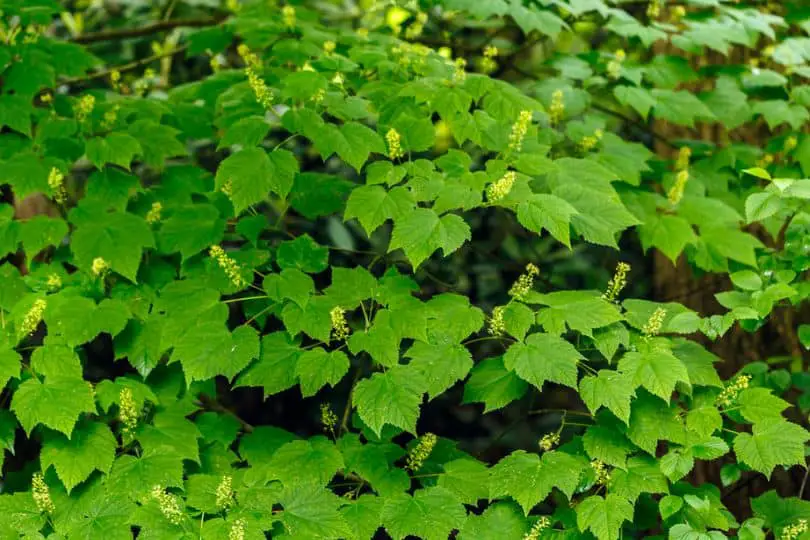
- Common Name: Rocky Mountain Maple
- Scientific Name: Acer glabrum
- Mature Height: Up to 20 feet
- Native/Non-Native: Native
- Flowers/Cones: Small, yellow-green flowers; U-shaped, pink samaras in summer
- Uses: Planted for landscaping purposes, prefers moist areas along streams
One of the shortest native maple trees in Utah, the Rocky Mountain Maple is native to the western Great Plains from the Mexican border to British Columbia. It can reach a height of up to 20 feet and likes wet, protected areas along streams. This plant tolerates shade and can be grown in protected regions or the shade of other trees, particularly in warm valleys.
Rocky Mountain Maple leaves are opposite, simple, and deciduous. They have 3-5 lobes and are 3-5 inches wide and length. The leaf margins are strongly and doubly serrate, and the hue is dark green above and paler below. The petiole is 1-4 inches long and slender, and the leaves turn yellow to a muted red in the fall.
This tree has slender, glabrous twigs that range in color from green to red-brown. The crimson buds are 1/8 to 1/4 inch long and feature one pair of visible scales. Rocky Mountain Maple flowers are primarily dioecious, with a few perfect blossoms. They are little and inconspicuous, appearing in late spring after the leaves have fallen.
This shrubby tree is infrequently planted in cultivated settings, presumably because it is not widely available in nurseries. The wood is unimportant and diffuse-porous, with a hard and solid character, and should be fairly resistant to high soil pH.
The Rocky Mountain Maple’s fruit is a samara, which is U-shaped and nearly parallel-winged, and measures 3/4 to 1 inch long. In the summer, the fruit is pink, but by the fall, it has turned pale brown and wrinkled. The bark is thin and rather smooth, and the hue is red-brown.
4. Norway Maple
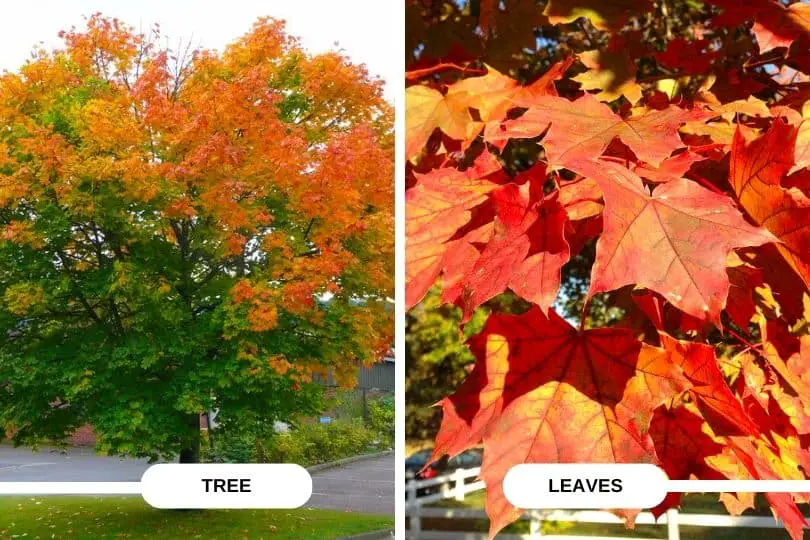
- Common Name: Norway Maple
- Scientific Name: Acer platanoides
- Mature Height: 40 to 50 feet tall
- Native/Non-Native: Non-Native
- Flowers/Cones: Dioecious flowers (yellow-green to yellow) and samaras (2 widespread wings)
- Uses: Shade tree and ornamental tree
Norway Maple is one of the most commonly found non-native naturalized maple trees in Utah. It is a deciduous tree that can reach heights of 50 feet.
The leaves of this tree are simple and opposite, with five lobes and varying shades of brilliant green to dark purple. The leaves turn a brilliant golden or yellow-orange in the autumn. Milky sap is evident when the petiole is split or taken from the stem, though this may vanish late in the summer.
Norway Maple twigs are robust and olive-brown, while the buds are spherical and green-red to scarlet. It blooms in the spring, with stunning yellow-green to-yellow flowers that appear as the leaves spread. The tree’s fruit is a samara with two broad wings that matures between September and October.
The tree is valued for its strong, wide crown and good summer and fall color, with numerous kinds available in leaf colors ranging from dark purple to bright green. Aphid honeydew can be a nuisance in some years, but the tree is rarely affected.
The Norway Maple, which is native to Europe from Norway’s south, has been widely planted in the United States, especially in Utah, and has been over-planted in some locations. Despite its adaptability to a wide range of environmental conditions, its leaves can sear in extremely hot and dry temperatures.
5. Sugar Maple
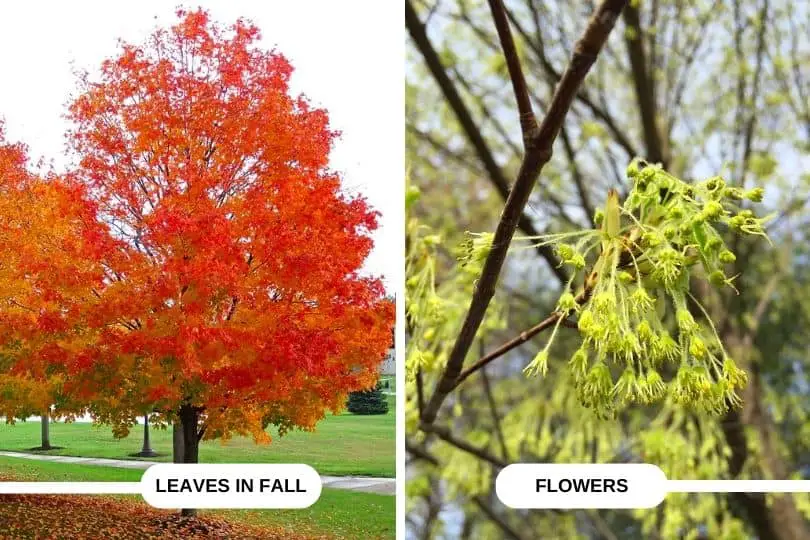
- Common Name: Sugar Maple
- Scientific Name: Acer saccharum
- Mature Height: 80-115 feet
- Native/Non-Native: Native to most of northeastern U.S.
- Flowers/Cones: Flowers are yellow-green and inconspicuous; the fruit is a U-shaped, double-winged samara
- Uses: Important in the eastern U.S. for its wood and maple syrup made from the sap
The sugar maple trees are the most useful species among native maple trees in Utah. It is a lovely tree that may be found throughout the northeastern United States that can grow to be a massive 115 feet tall tree.
Sugar maple leaves are opposite, simple, and palmately 5-lobed. They are 3-5 inches wide and long and are brilliant yellow-green with glabrous upper and lower surfaces. The leaves turn bright crimson, orange, or yellow in the fall, creating a stunning spectacle.
Sugar maple blossoms are yellow-green and quite inconspicuous in the spring. The fruit is a U-shaped, double-winged samara. It normally reaches maturity in the fall.
This tree is also well-known for producing wonderful maple syrup from its sap. Because of its attractive crown form and brilliant fall color, the sugar maple is well-suited to the landscape. It can thrive in Utah but should be avoided in severely hot and dry conditions.
The sugar maple is shade tolerant and can be found in Logan and other parts of Utah. It works best in Zones 4-8.
On older trees, the bark of the sugar maple is gray and heavily furrowed, with long, uneven plates or ridges. Its wood is valuable in the eastern United States because it is of superior quality to that of other maples. It has white sapwood with a crimson tinge and light brown heartwood with noticeable growth rings. Sugar maple is the most important commercial maple for forest products.
6. Silver Maple
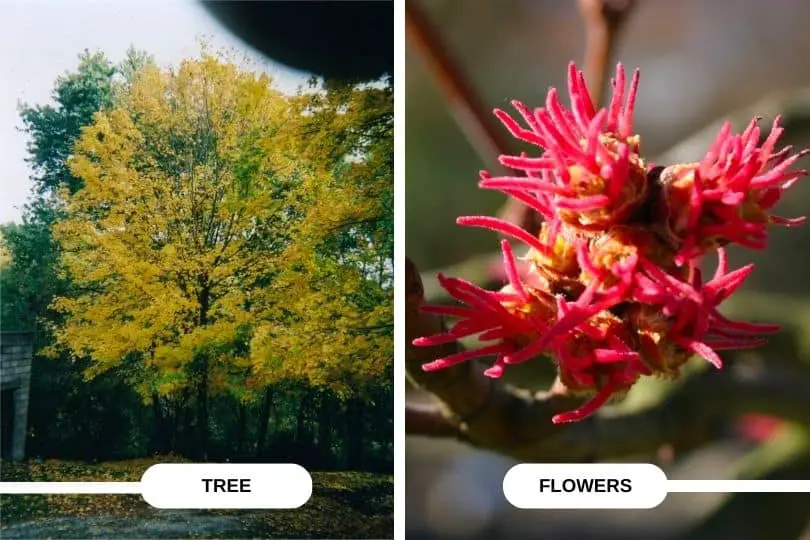
- Common Name: Silver Maple
- Scientific Name: Acer saccharinum
- Mature Height: 50-80 feet
- Native/Non-Native: Native
- Flowers/Cones: Red to yellow-green flowers; samara fruit
- Uses: Substituted for sugar maple in furniture and flooring; also used in boxes, pallets, crates, and novelties.
For some reason, if you don’t want to grow sugar maple in your yard, then Silver Maple could be exactly what you’re looking for. After sugar maple, silver maples are the second most frequently planted maple trees in Utah.
This tree is native to the majority of the eastern United States and thrives in damp, bottomland environments. It can reach a height of 80 feet and a width of 50 feet, making it a massive and frequently stunning addition to any landscape.
The Silver Maple has some distinguishing qualities. Its leaves are palmately 5-lobed and range in size from 4 to 7 inches wide and long. The leaf’s upper surface is green and glabrous, while the below surface is silver-white. The leaves turn pale yellow and fall off the tree in autumn.
Silver Maple twigs are slender and orange-brown to crimson in hue. It has spherical, crimson to reddish-brown buds that are crowded. Because the flowers appear early, before the leaves, the tree produces red to yellow-green blossoms that are quite showy. Its fruit is a samara with two wings that spread widely and germinate quickly.
The wood of the Silver Maple is somewhat important, and it is used as a substitute for sugar maple in flooring, furniture, boxes, pallets, crates, and novelty items. However, the tree is frail and can easily shatter in a storm. It also suffers from iron chlorosis in the West due to high soil pH, so it should only be grown in areas with plenty of space and low soil pH.
7. Red Maple

- Common Name: Red Maple
- Scientific Name: Acer rubrum
- Mature Height: Up to 72 feet
- Native/Non-Native: Native to most of the eastern U.S.
- Flowers/Cones: Dioecious flowers; samara fruit
- Uses: Landscape, wood
The Red Maple, formally known as Acer rubrum, is a deciduous tree endemic to most of the eastern United States that may grow to heights of 72 feet. It has opposite, simple leaves that are palmately three-lobed and coarsely serrated and range in width from 2 to 6 inches. The leaves turn a beautiful scarlet in the fall, making it a popular landscape tree.
When crushed, the twigs of the red maple are slender and dark crimson, with no disagreeable odor. The terminal bud is red to green and does not have a tip. The blooms are dioecious and crimson, and the fruits, which mature in late spring, are samaras with two slightly spread wings that form a V shape.
On young stems, the bark is smooth and light gray, gradually breaking into long, scaly plates divided by shallow furrows. The sapwood of the tree is white, with a light brown heartwood that has diffuse-porous growth rings and is not very distinct. Red maple has weaker wood than silver maple and can be utilized for similar applications.
Red Maple is a medium-sized tree with intermediate shade tolerance that is occasionally planted in Utah. It does not, however, develop as quickly as silver maple and has weaker wood. Chlorosis in high pH soils owing to manganese deficiency is one issue with this tree.
Despite these drawbacks, Red Maple has good fall color and a wide range of cultivars, making it an attractive and popular tree in landscapes around the country. USDA hardiness zones 3–9 are suitable for growing the plant.
8. Amur Maple
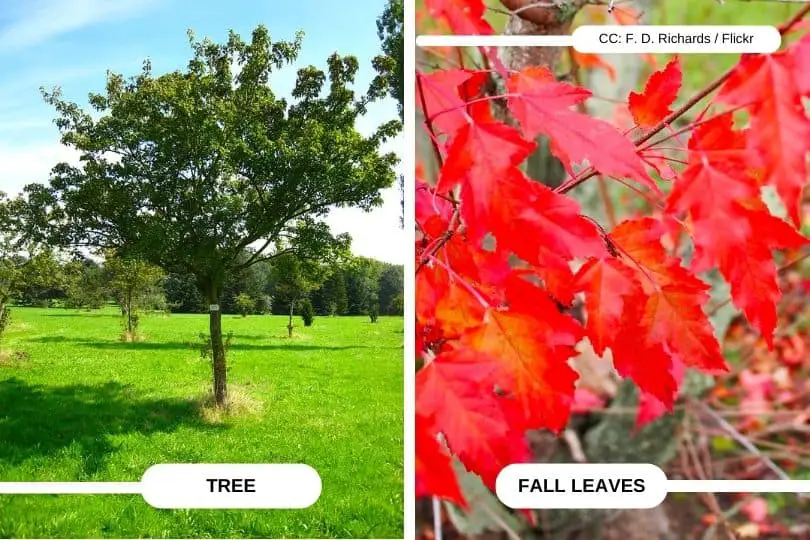
- Common Name: Amur Maple
- Scientific Name: Acer ginnala
- Mature Height: 10-20 feet tall
- Native/Non-Native: Non-Native
- Flowers/Cones: Yellow-white flowers; Fruit is a samara (2 parallel wings)
- Uses: Ornamental tree, shade tree, windbreak
The Amur Maple (Acer ginnala) is a non-native tree that can grow to 20 feet tall. It is indigenous to China’s central and northern regions, Manchuria, and Japan.
The Amur Maple’s leaves are dark green and shiny on the top and bright green on the bottom. They have three lobes that are palmately divided, with the center lobe being longer than the side lobes. The leaves have a double serrate margin, which means the edges are wavy, like a saw blade.
The Amur Maple’s twigs are slender and gray-brown. The buds are reddish brown and glabrous, which means hairless. The Amur Maple has little yellow-white blooms that appear alongside the leaves. The fruit is a samara with two parallel wings that ripen in the fall.
The Amur Maple is a popular ornamental tree that is frequently utilized as a windbreak or shade tree. There are numerous commercially available Amur Maple variants, ranging from small shrubs to small trees.
It should be noted, however, that Amur Maple is not well-suited to high-pH soils and can develop chlorosis in these conditions. If you want to plant an Amur Maple, you should do it in locations where the soil pH is low, close to 7.
The Amur Maple’s fall color can be spectacular, although it is erratic. If you live in Zones 2-8, you might be able to enjoy the vivid fall colors of this tree.
9. Hedge Maple
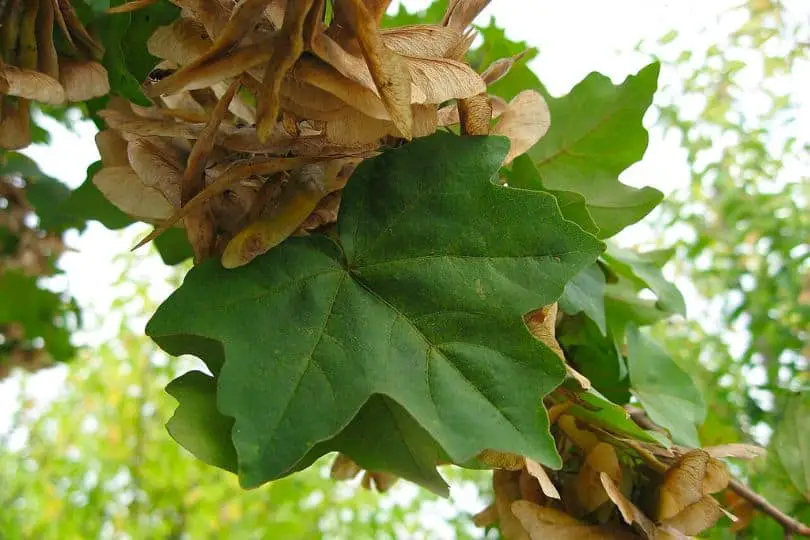
- Common Name: Hedge Maple
- Scientific Name: Acer campestre
- Mature Height: 20-30 feet
- Native/Non-Native: Native to Europe, Africa, and western Asia
- Flowers/Fruit: Fruit a samara; 1″ to 1-3/4″ long; wings very widespread.
- Uses: Medium-sized tree widely used as a hedge in Europe, and can stand heavy pruning for that purpose
Hedge Maple, also known as Acer campestre, is a medium-sized tree that is often utilized as a hedge in Europe. Although the tree is native to Europe, Africa, and Western Asia, it thrives in Utah due to its tolerance for dry, alkaline soils.
The leaves of the tree are 2 to 4 inches wide and long, with three to five lobes and a few rounded teeth. They have a 4-inch-long petiole that emits a milky sap when broken and is dark green on top and pubescent underneath. The leaves become yellow in the autumn season.
When inspecting the tree’s twigs, look for conspicuous lenticels, whereas older twigs have corky ridges. The pith of the tree is white and solid, making it easy to identify.
The fruit of the Hedge Maple is a samara that is 1 to 1-3/4 inches long and has wings that spread widely. The tree thrives in well-drained soil, high soil PH, compaction, pollution, and dry areas, although it is shade intolerant to moderately shade tolerant. It is also largely pest-free.
If you want to use a Hedge Maple as a hedge, it tolerates heavy pruning well. However, after they have gotten large, they should not be excessively pruned. The Hedge Maple is hardy in Zones 4-8, making it a useful tree in many parts of the country.
10. Sycamore Maple
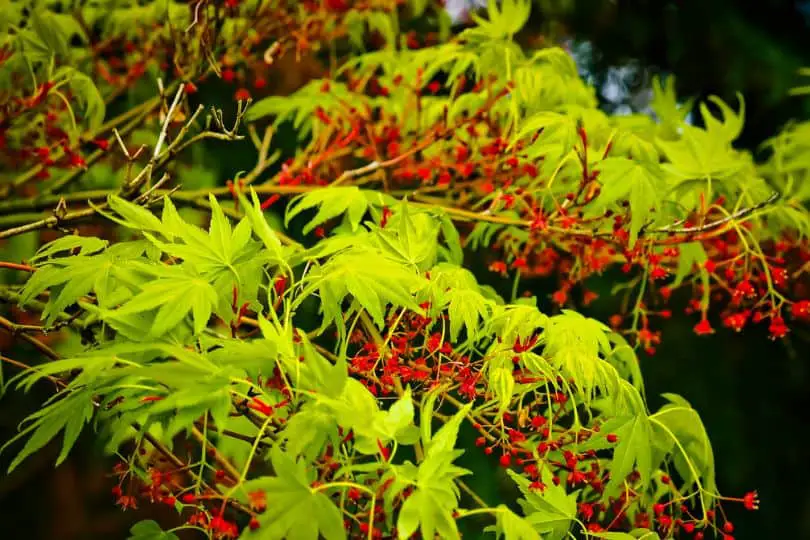
- Common Name: Sycamore Maple
- Scientific Name: Acer pseudoplatanus
- Mature Height: Up to 100 feet
- Native/Non-native: Native to Europe and Western Asia
- Flowers/Cones: The fruit is a samara, wings angled at about 60 degrees from one another
- Uses: Ornamental, timber production
Sycamore Maple is a huge, attractive tree that can reach heights of 100 feet. It is native to Europe and Western Asia, but it has been extensively planted throughout Europe, and it is highly adaptable to a wide range of soil and weather conditions. It is also extremely salt tolerant.
The leaves are five-lobed and dark green above and paler beneath, with a yellow to brown fall color. The twigs are dark with strong lenticels and are slightly four-angled, whereas the buds are green all winter. The fruit is a samara with wings that are oriented at about 60 degrees from each other and matures in the fall.
Sycamore Maple bark is gray and reddish-brown to orange, with scaly flakes exposing the orange inner bark. The tree is shade intolerant to shade tolerant.
Sycamore Maple is a common timber species, but it is not favored above other hardwoods. The tree has ornamental significance as well, and it requires extensive pruning to stay in good form in the landscape. It is similar to Norway Maple and can be found flourishing in parks throughout Utah County.
11. Trident Maple

- Common Name: Trident Maple
- Scientific Name: Acer buergeranum
- Mature Height: Small to Medium-sized tree, up to 25-30 ft
- Native/Non-Native: Native to China.
- Flowers/Cones: Produces samara fruit that is about 3/4 to 1 inch long.
- Uses: Perfect for landscape use and adds great fall colors to any garden.
If you’re seeking a beautiful tree to add to your garden, try the Trident Maple. This little to medium-sized tree is native to China, however, it may be found in many gardens worldwide. The scientific name for this tree is Acer buergeranum, although it is more frequently known as the Trident Maple.
The leaves of the Trident Maple are one of its most distinguishing characteristics. They have three lobes and are a bright green color. The lobes are forward-facing and include three main veins, as well as tiny teeth dispersed throughout. When the leaves develop, they can reach a width of 3 inches. They turn yellow, orange, or crimson in the fall, making them a lovely accent to any fall garden.
The flowers and fruit of the Trident Maple are equally lovely. The tree produces samaras, which are 1-inch long-winged seed pods. They fall to the ground in the autumn, thus the tree requires very little upkeep.
The bark of the Trident Maple is also beautiful. After a few years, it turns gray, orange, brown, and scaly, making it ideal for landscaping. This tree is also drought-tolerant and grows well in zones 5-9.
12. Paperbark Maple
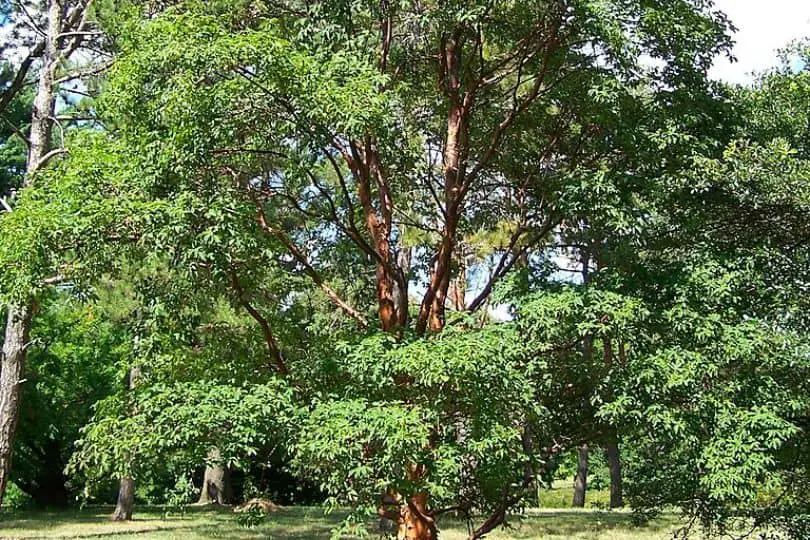
- Common Name: Paperbark Maple
- Scientific Name: Acer griseum
- Mature Height: Small to medium-sized tree, up to 30 feet tall
- Native/Non-Native: Native to China
- Flowers/Cones: Samaras, 1-1/2″ long, wings at 60 to a 90-degree angle; fall maturing
The Paperbark Maple (Acer griseum) is a lovely little to medium-sized tree endemic to China. It may grow up to 30 feet tall and has a distinguishing trait that sets it apart from other trees: its bark. The peeling red-brown bark on the elder twigs and trunk of the Paperbark Maple is both beautiful to look at and touch.
Paperbark Maple leaves are compound, which means they have three leaflets that are roughly 3″ to 6″ long. They have few coarse teeth, are blue-green and smooth on top, and are pubescent beneath the veins. The leaf’s petiole is 2″ to 3″ long and pubescent, and the fall color is crimson, making it an appealing addition to any garden.
The Paperbark Maple blooms in the fall and produces samaras. They are 1-1/2″ long, pubescent, and have wings that angle from 60 to 90 degrees. It is a wonderful tree to grow in Utah since it is drought-resistant and can survive a variety of soil conditions, including relatively high pH, although it is shade intolerant.
The Paperbark Maple is an excellent choice if you want to add an unusual yet beautiful small to medium-sized tree to your garden. Its bark will add a unique and stunning feature to your garden, and its fall colors will give your garden a pop of red.
13. Japanese Maple
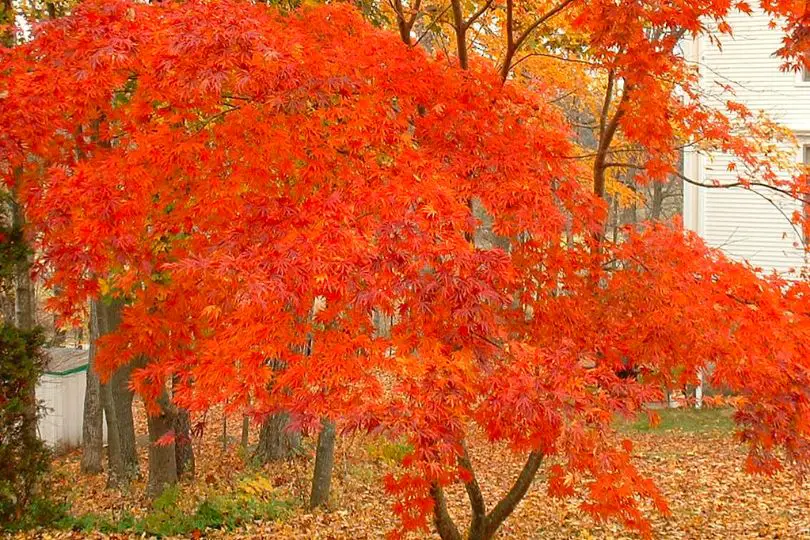
- Common Name: Japanese Maple
- Scientific Name: Acer palmatum
- Mature Height: 10-25 feet
- Native/Non-Native: Native to China, Japan, and Korea
- Flowers/Cones: Fruit a samara; 1/2″ to 3/4″ long; wings curved in toward one another; fall maturing.
The Japanese Maple is a stunning small tree native to China, Japan, and Korea that grows to a height of 10-25 feet. The leaves are deeply 5- to 9-lobed and can be 2″ to 5″ long, with a doubly serrate edge. The color of the leaves can range from green to reddish-purple depending on the cultivar, and they turn yellow, orange, purple, or red in the fall.
The Japanese Maple’s fruit is a samara, which is about 1/2″ to 3/4″ long and has wings that curve in towards one another; the fruit falls off the tree and matures during the fall.
Although the Japanese Maple is a beautiful sight to behold, it does not tolerate cold or intense heat. It has intermediate shade tolerance and is best planted where afternoon shade and wind protection are available.
14. Tatarian Maple
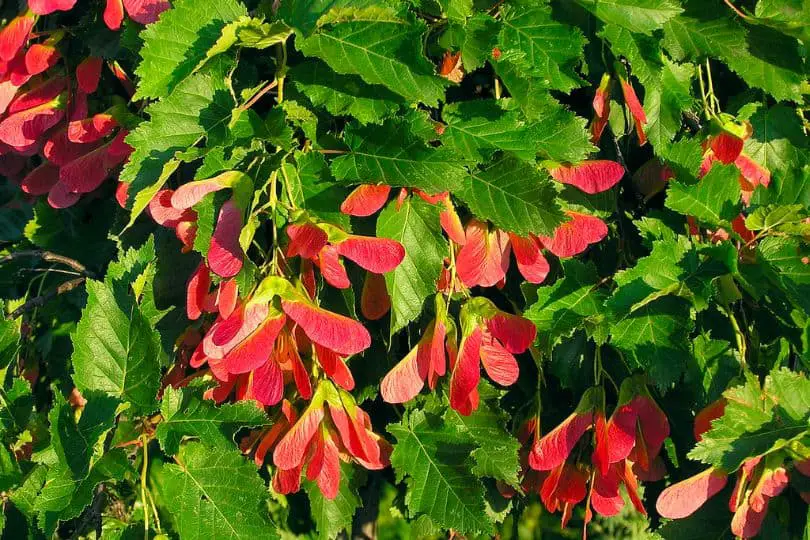
- Common Name: Tatarian Maple
- Scientific Name: Acer tataricum
- Mature Height: 20-30 feet
- Native/Non-Native: Native to southeastern Europe and western Asia
- Flowers/Cones: Greenish-white flowers; red fruit (samara) with parallel wings
- Uses: Landscaping
Tatarian Maple, also known as Acer tataricum, is a beautiful small tree that grows up to 20-30 feet tall and is native to southeastern Europe and western Asia. Its leaves are similar to Amur maple, with bright green and unlobed or slightly 3-lobed leaves that are doubly serrated and can be 2″ to 4″ long. The leaves turn yellow or red in the fall, providing beautiful colors.
Tatarian Maple blooms are greenish-white and rather decorative, and the fruit is a samara that is 3/4″ to 1″ long, with parallel and crimson wings for several weeks before maturing in the fall. Tatarian Maple is drought-resistant and adaptable, however, it is not shade tolerant.
Tatarian Maple is a small, shrubby maple that is not commonly planted in Utah, but it is an excellent substitute for Amur Maple, particularly in areas where drought-tolerant plants are preferred. The red fruit is quite attractive and adds a beautiful touch to any landscape.
Tatarian Maple is an excellent choice for landscaping and can be used in place of Amur Maple if you want to add some color to your landscape.
15. Shantung Maple
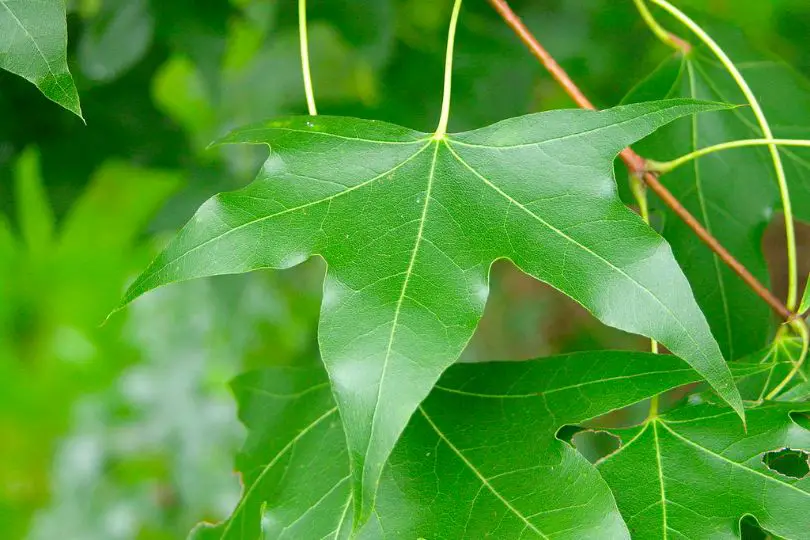
- Common Name: Purpleblow Maple
- Scientific Name: Acer truncatum
- Mature Height: Small to medium-sized tree
- Native/Non-Native: Native to China
- Flowers/Cones and Uses: Fruit
- Uses: Ornamental due to good fall color
The Purpleblow Maple, also known as the Shantung Maple, is a small to medium-sized tree native to China. Its leaves have five triangular lobes with no teeth and are 3″ to 5″ wide when young, but mature leaves are dark green and lighter on the bottom. The petiole is 2″ to 4″ long and has milky sap when broken, and the fall colors range from yellow to orange and red.
The Purpleblow Maple’s fruit is a samara that is 1-1/4″ to 1-1/2″ long and sometimes purple-colored, with wings at a 90-degree angle. This tree is drought and heat-resistant and adapts well to different growing conditions, but it is shade intolerant. It is most commonly found in Zones 4-8.
The Purpleblow Maple is commonly used for landscaping; it is uncommon in Utah, but it is an excellent choice for people seeking a small to medium-sized tree with good fall color; it is also pest-free and takes little maintenance.
Its unusual purplish color when young and stunning fall colors make it ideal for anybody wishing to improve the visual attractiveness of their home, and it is also a terrific tree to put in your backyard or front yard, where you may enjoy its beauty for years to come with no upkeep.
Similar Articles
- Common Oak Trees In Utah
- Common Pine Trees In Utah
- Common Mulberry Trees In Utah
- Common Magnolia Trees In Utah
- Common Ash Trees In Utah
- Common Spruce Trees In Utah
- Common Elm Trees In Utah
- Common Birch Trees In Utah
- Common Poplar Trees In Utah
- Common Dogwood Trees In Utah
- Common Nut Trees In Utah
- Common Pear Trees In Utah
- Common Cedar Trees In Utah
- Common Willow Trees In Utah
- Common Alder Trees In Utah
- Common Cypress Trees In Utah
- Common Beech Trees In Utah
- Common Juniper Trees In Utah
- Common Fir Trees In Utah
- Common Plum & Cherry Trees In Utah
- Common Palm Trees In Utah
Common Maple Trees In Utah – Sources
The Regional Gardening team makes sure that the information in our articles is accurate by only using sources that are known to be trustworthy. Some of these sources are peer-reviewed journals from government agencies, well-known universities, and scientific research organizations.
- Trees & Shrubs In Yard And Garden, Utah State University Extension
- Native & Non-Native Tree Identification, Utah State University Forestry Extension.
- Native Plants, Utah Native Plant Society.
- A Guide To The Trees Of Utah & Intermountain West, Book By Michael Kuhns, Utah State University Press.


